Business Operations Report: Analyzing Unilever's Strategies and Impact
VerifiedAdded on 2020/06/04
|11
|2874
|39
Report
AI Summary
This report examines the business operations of Unilever, a major British consumer goods company. It covers various aspects of business, including private, public, and non-profit sectors, and explores different business structures like sole proprietorships and corporations. The report analyzes the impact of local, national, and global economic environments on enterprises and highlights the importance of accounting for organizational success. It also delves into the functions of the HR department, key features of worker legislation, and presents a profit and loss account for Unilever. Furthermore, the report discusses team development, the impact of client services, and the benefits of consumer profiling. It provides insights into Unilever's strategies and their impact on the company's performance in the market.
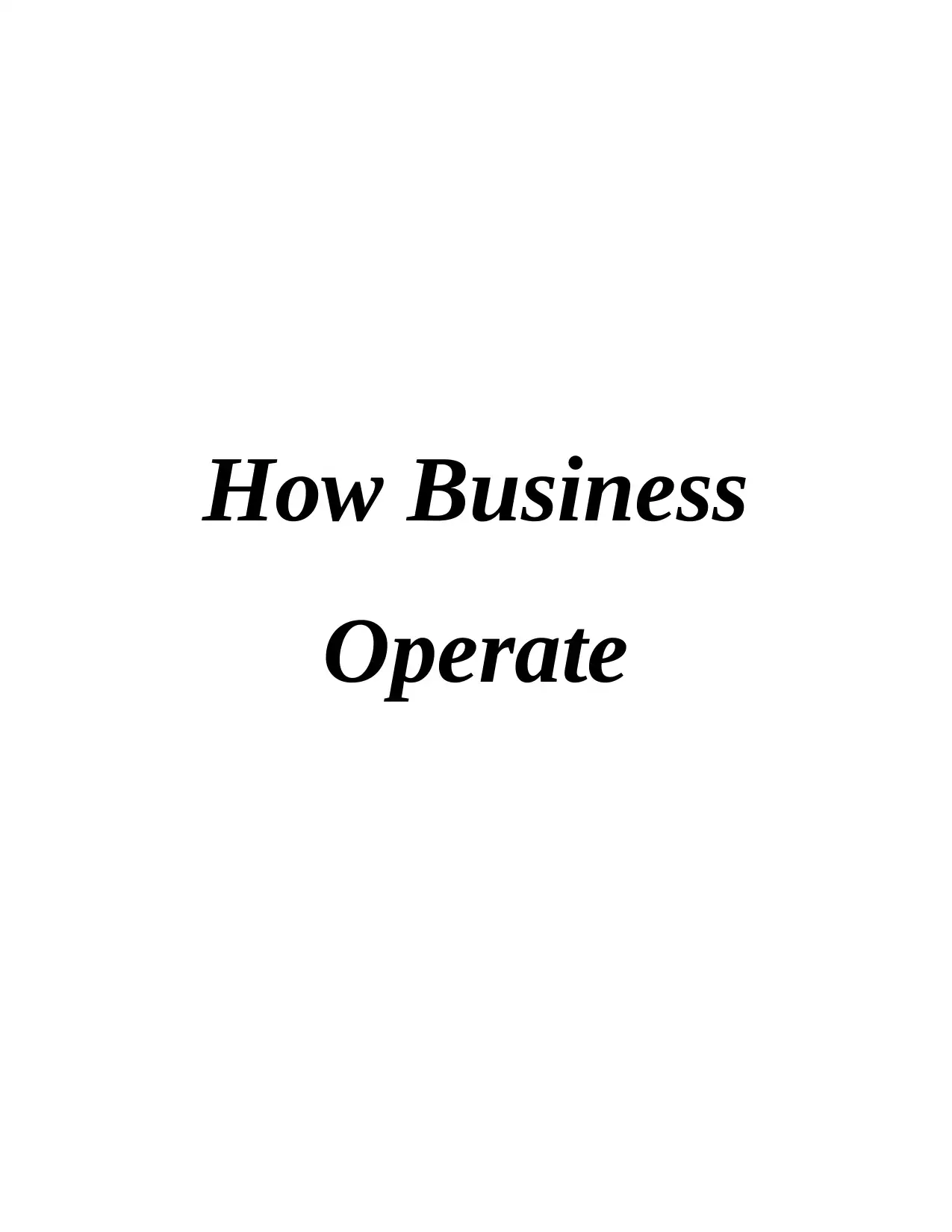
How Business
Operate
Operate
Paraphrase This Document
Need a fresh take? Get an instant paraphrase of this document with our AI Paraphraser
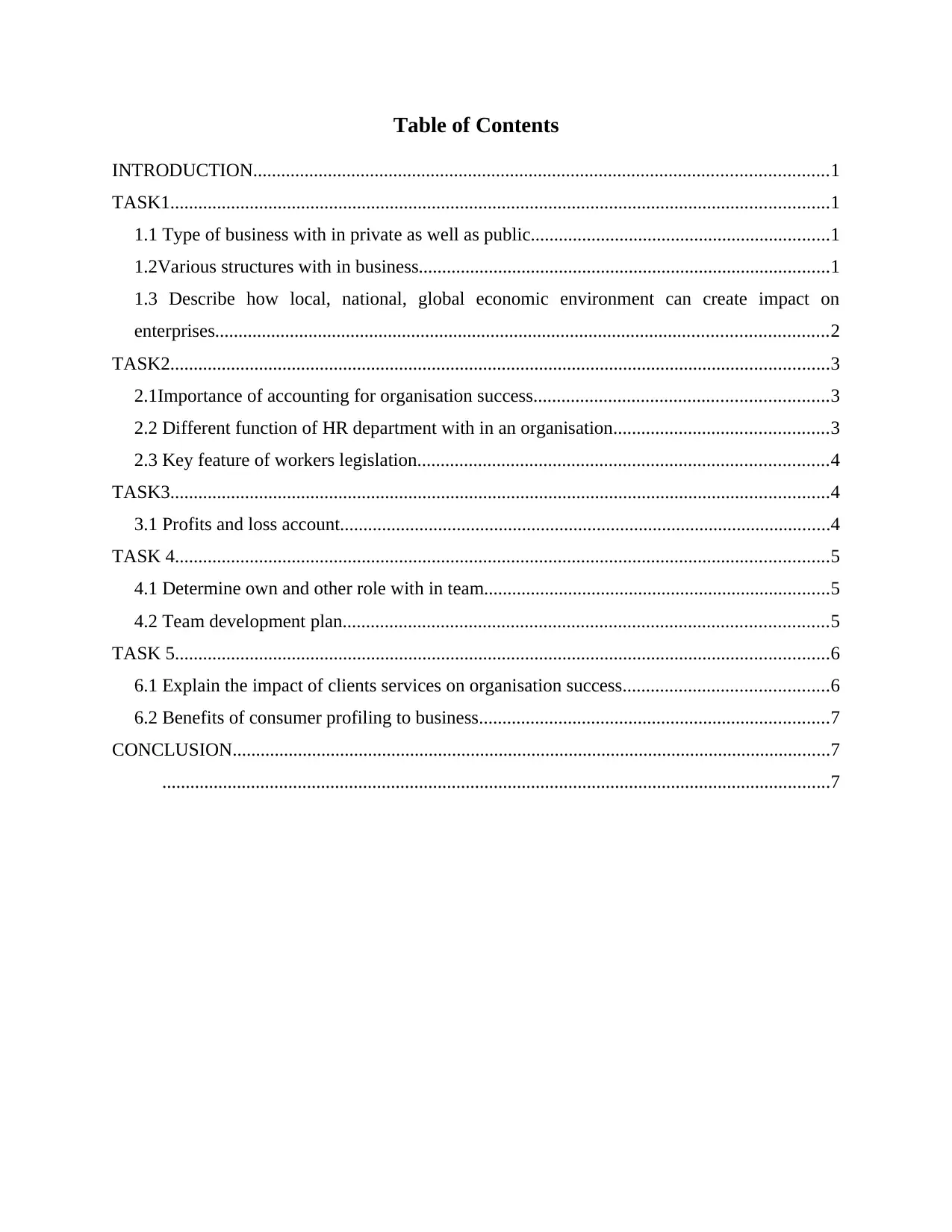
Table of Contents
INTRODUCTION...........................................................................................................................1
TASK1.............................................................................................................................................1
1.1 Type of business with in private as well as public................................................................1
1.2Various structures with in business........................................................................................1
1.3 Describe how local, national, global economic environment can create impact on
enterprises...................................................................................................................................2
TASK2.............................................................................................................................................3
2.1Importance of accounting for organisation success...............................................................3
2.2 Different function of HR department with in an organisation..............................................3
2.3 Key feature of workers legislation........................................................................................4
TASK3.............................................................................................................................................4
3.1 Profits and loss account.........................................................................................................4
TASK 4............................................................................................................................................5
4.1 Determine own and other role with in team..........................................................................5
4.2 Team development plan........................................................................................................5
TASK 5............................................................................................................................................6
6.1 Explain the impact of clients services on organisation success............................................6
6.2 Benefits of consumer profiling to business...........................................................................7
CONCLUSION................................................................................................................................7
...............................................................................................................................................7
INTRODUCTION...........................................................................................................................1
TASK1.............................................................................................................................................1
1.1 Type of business with in private as well as public................................................................1
1.2Various structures with in business........................................................................................1
1.3 Describe how local, national, global economic environment can create impact on
enterprises...................................................................................................................................2
TASK2.............................................................................................................................................3
2.1Importance of accounting for organisation success...............................................................3
2.2 Different function of HR department with in an organisation..............................................3
2.3 Key feature of workers legislation........................................................................................4
TASK3.............................................................................................................................................4
3.1 Profits and loss account.........................................................................................................4
TASK 4............................................................................................................................................5
4.1 Determine own and other role with in team..........................................................................5
4.2 Team development plan........................................................................................................5
TASK 5............................................................................................................................................6
6.1 Explain the impact of clients services on organisation success............................................6
6.2 Benefits of consumer profiling to business...........................................................................7
CONCLUSION................................................................................................................................7
...............................................................................................................................................7
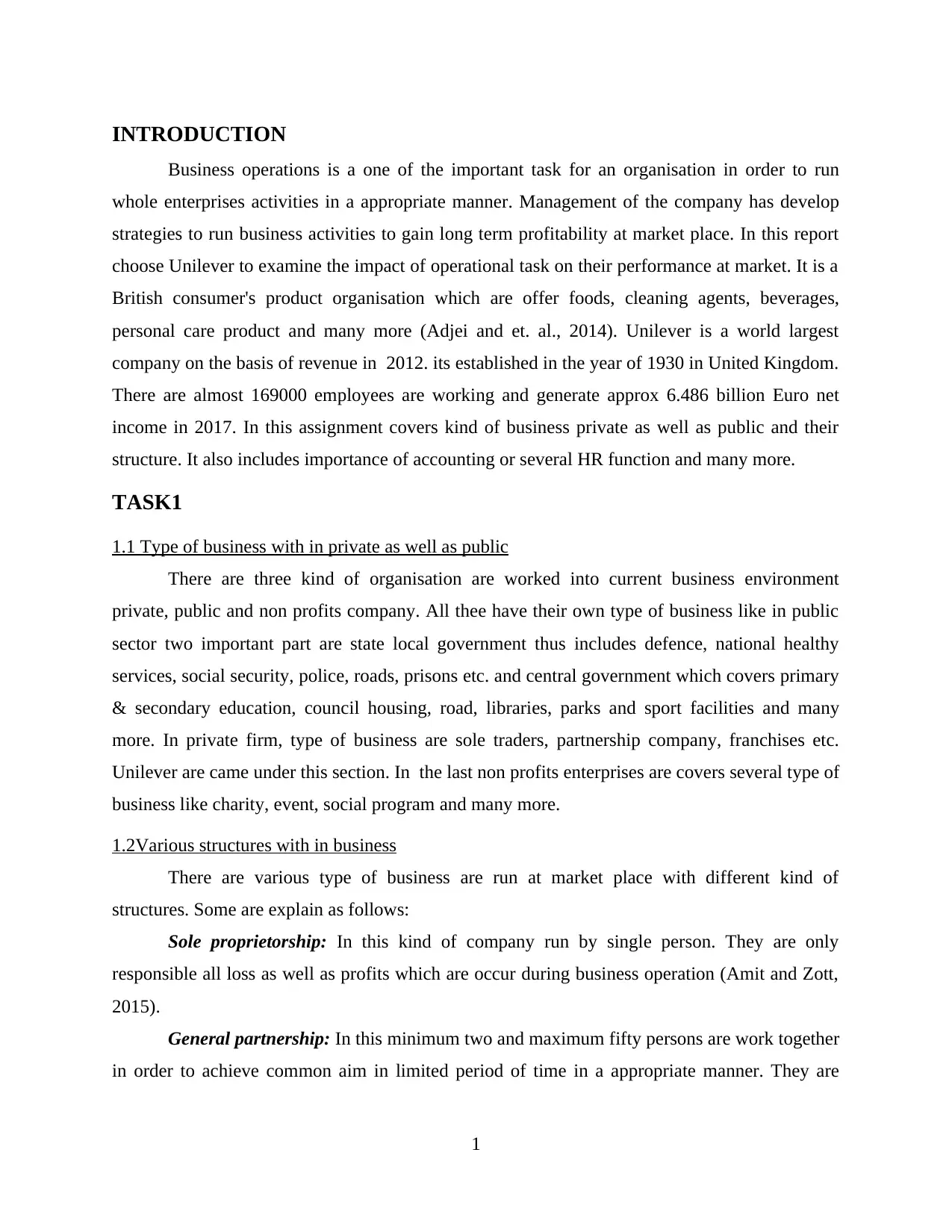
INTRODUCTION
Business operations is a one of the important task for an organisation in order to run
whole enterprises activities in a appropriate manner. Management of the company has develop
strategies to run business activities to gain long term profitability at market place. In this report
choose Unilever to examine the impact of operational task on their performance at market. It is a
British consumer's product organisation which are offer foods, cleaning agents, beverages,
personal care product and many more (Adjei and et. al., 2014). Unilever is a world largest
company on the basis of revenue in 2012. its established in the year of 1930 in United Kingdom.
There are almost 169000 employees are working and generate approx 6.486 billion Euro net
income in 2017. In this assignment covers kind of business private as well as public and their
structure. It also includes importance of accounting or several HR function and many more.
TASK1
1.1 Type of business with in private as well as public
There are three kind of organisation are worked into current business environment
private, public and non profits company. All thee have their own type of business like in public
sector two important part are state local government thus includes defence, national healthy
services, social security, police, roads, prisons etc. and central government which covers primary
& secondary education, council housing, road, libraries, parks and sport facilities and many
more. In private firm, type of business are sole traders, partnership company, franchises etc.
Unilever are came under this section. In the last non profits enterprises are covers several type of
business like charity, event, social program and many more.
1.2Various structures with in business
There are various type of business are run at market place with different kind of
structures. Some are explain as follows:
Sole proprietorship: In this kind of company run by single person. They are only
responsible all loss as well as profits which are occur during business operation (Amit and Zott,
2015).
General partnership: In this minimum two and maximum fifty persons are work together
in order to achieve common aim in limited period of time in a appropriate manner. They are
1
Business operations is a one of the important task for an organisation in order to run
whole enterprises activities in a appropriate manner. Management of the company has develop
strategies to run business activities to gain long term profitability at market place. In this report
choose Unilever to examine the impact of operational task on their performance at market. It is a
British consumer's product organisation which are offer foods, cleaning agents, beverages,
personal care product and many more (Adjei and et. al., 2014). Unilever is a world largest
company on the basis of revenue in 2012. its established in the year of 1930 in United Kingdom.
There are almost 169000 employees are working and generate approx 6.486 billion Euro net
income in 2017. In this assignment covers kind of business private as well as public and their
structure. It also includes importance of accounting or several HR function and many more.
TASK1
1.1 Type of business with in private as well as public
There are three kind of organisation are worked into current business environment
private, public and non profits company. All thee have their own type of business like in public
sector two important part are state local government thus includes defence, national healthy
services, social security, police, roads, prisons etc. and central government which covers primary
& secondary education, council housing, road, libraries, parks and sport facilities and many
more. In private firm, type of business are sole traders, partnership company, franchises etc.
Unilever are came under this section. In the last non profits enterprises are covers several type of
business like charity, event, social program and many more.
1.2Various structures with in business
There are various type of business are run at market place with different kind of
structures. Some are explain as follows:
Sole proprietorship: In this kind of company run by single person. They are only
responsible all loss as well as profits which are occur during business operation (Amit and Zott,
2015).
General partnership: In this minimum two and maximum fifty persons are work together
in order to achieve common aim in limited period of time in a appropriate manner. They are
1
⊘ This is a preview!⊘
Do you want full access?
Subscribe today to unlock all pages.

Trusted by 1+ million students worldwide
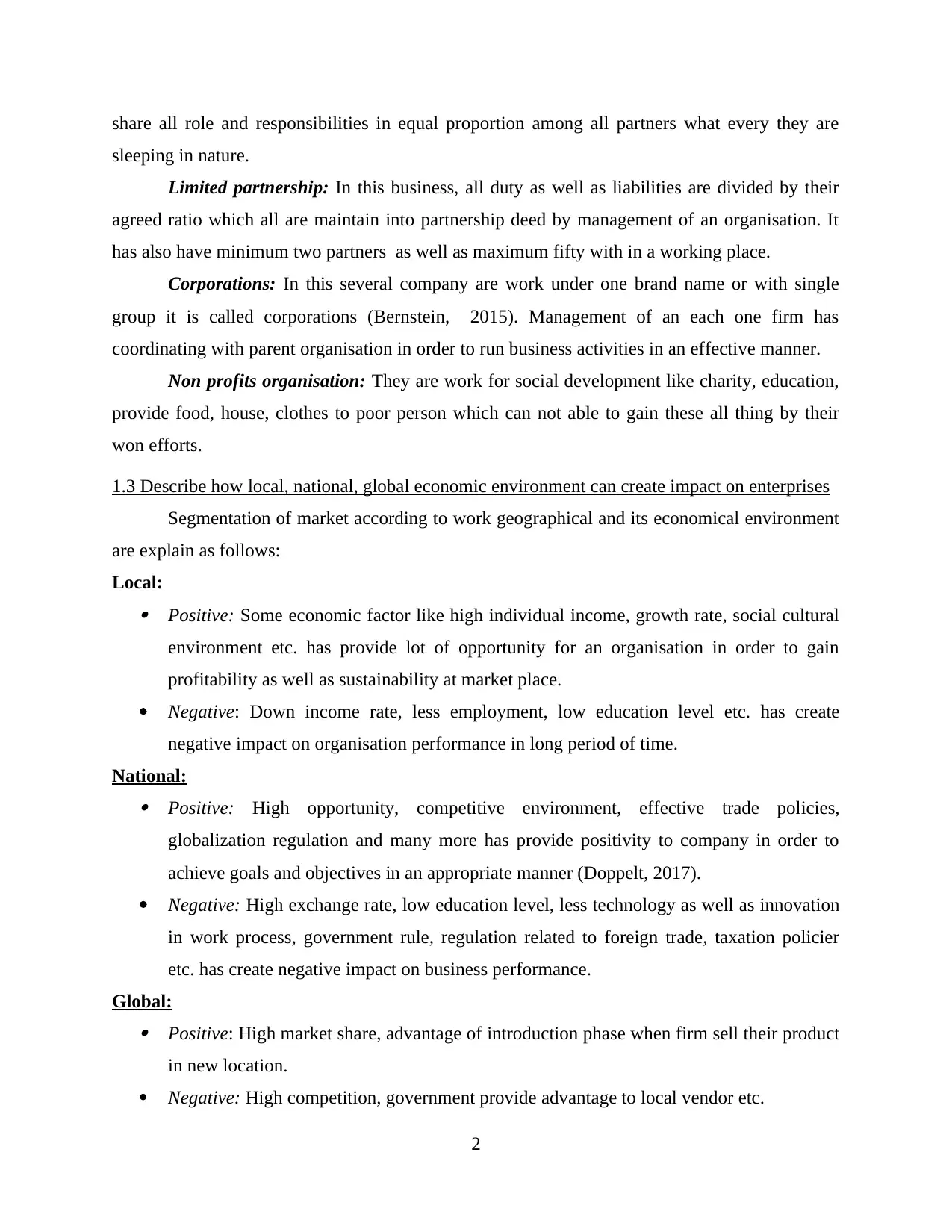
share all role and responsibilities in equal proportion among all partners what every they are
sleeping in nature.
Limited partnership: In this business, all duty as well as liabilities are divided by their
agreed ratio which all are maintain into partnership deed by management of an organisation. It
has also have minimum two partners as well as maximum fifty with in a working place.
Corporations: In this several company are work under one brand name or with single
group it is called corporations (Bernstein, 2015). Management of an each one firm has
coordinating with parent organisation in order to run business activities in an effective manner.
Non profits organisation: They are work for social development like charity, education,
provide food, house, clothes to poor person which can not able to gain these all thing by their
won efforts.
1.3 Describe how local, national, global economic environment can create impact on enterprises
Segmentation of market according to work geographical and its economical environment
are explain as follows:
Local: Positive: Some economic factor like high individual income, growth rate, social cultural
environment etc. has provide lot of opportunity for an organisation in order to gain
profitability as well as sustainability at market place.
Negative: Down income rate, less employment, low education level etc. has create
negative impact on organisation performance in long period of time.
National: Positive: High opportunity, competitive environment, effective trade policies,
globalization regulation and many more has provide positivity to company in order to
achieve goals and objectives in an appropriate manner (Doppelt, 2017).
Negative: High exchange rate, low education level, less technology as well as innovation
in work process, government rule, regulation related to foreign trade, taxation policier
etc. has create negative impact on business performance.
Global: Positive: High market share, advantage of introduction phase when firm sell their product
in new location.
Negative: High competition, government provide advantage to local vendor etc.
2
sleeping in nature.
Limited partnership: In this business, all duty as well as liabilities are divided by their
agreed ratio which all are maintain into partnership deed by management of an organisation. It
has also have minimum two partners as well as maximum fifty with in a working place.
Corporations: In this several company are work under one brand name or with single
group it is called corporations (Bernstein, 2015). Management of an each one firm has
coordinating with parent organisation in order to run business activities in an effective manner.
Non profits organisation: They are work for social development like charity, education,
provide food, house, clothes to poor person which can not able to gain these all thing by their
won efforts.
1.3 Describe how local, national, global economic environment can create impact on enterprises
Segmentation of market according to work geographical and its economical environment
are explain as follows:
Local: Positive: Some economic factor like high individual income, growth rate, social cultural
environment etc. has provide lot of opportunity for an organisation in order to gain
profitability as well as sustainability at market place.
Negative: Down income rate, less employment, low education level etc. has create
negative impact on organisation performance in long period of time.
National: Positive: High opportunity, competitive environment, effective trade policies,
globalization regulation and many more has provide positivity to company in order to
achieve goals and objectives in an appropriate manner (Doppelt, 2017).
Negative: High exchange rate, low education level, less technology as well as innovation
in work process, government rule, regulation related to foreign trade, taxation policier
etc. has create negative impact on business performance.
Global: Positive: High market share, advantage of introduction phase when firm sell their product
in new location.
Negative: High competition, government provide advantage to local vendor etc.
2
Paraphrase This Document
Need a fresh take? Get an instant paraphrase of this document with our AI Paraphraser
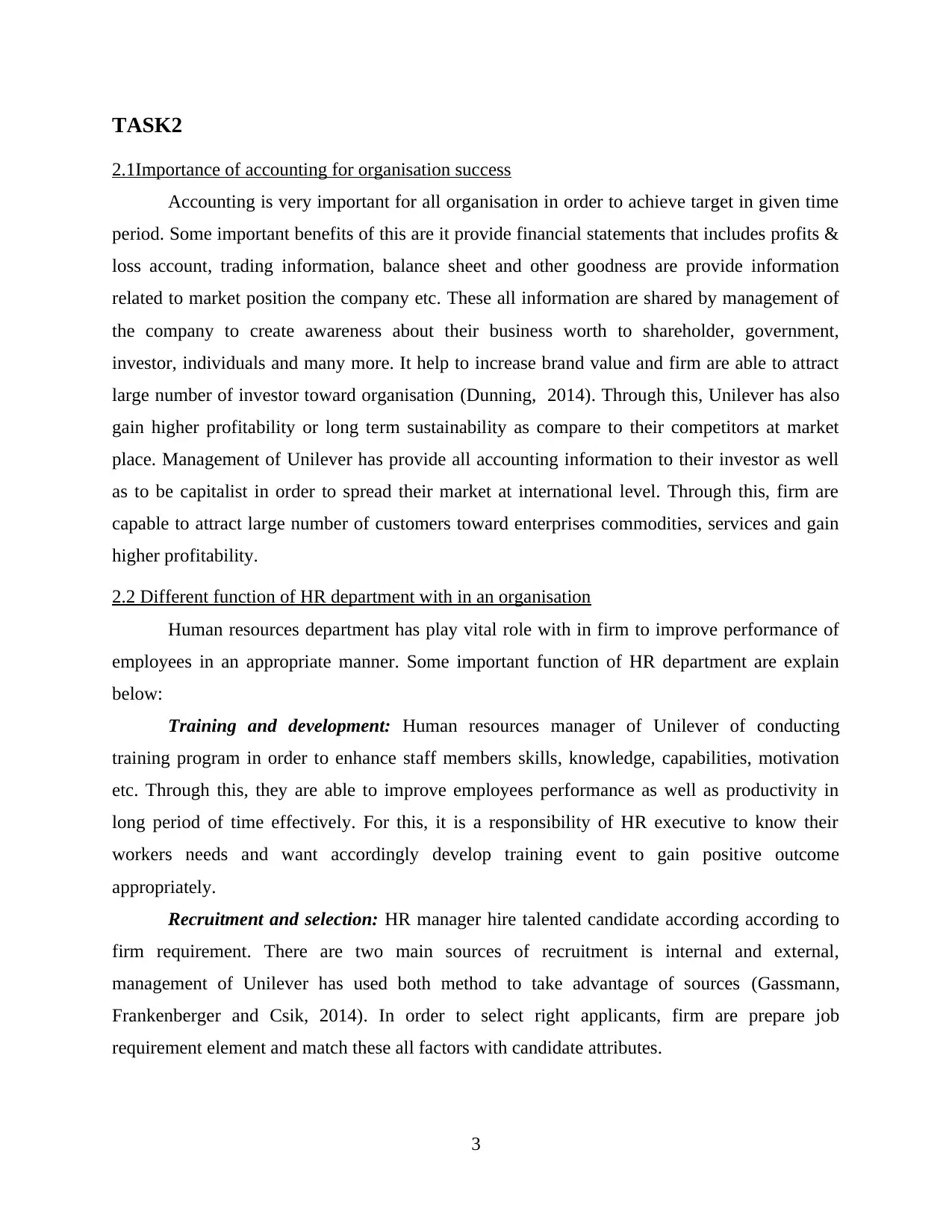
TASK2
2.1Importance of accounting for organisation success
Accounting is very important for all organisation in order to achieve target in given time
period. Some important benefits of this are it provide financial statements that includes profits &
loss account, trading information, balance sheet and other goodness are provide information
related to market position the company etc. These all information are shared by management of
the company to create awareness about their business worth to shareholder, government,
investor, individuals and many more. It help to increase brand value and firm are able to attract
large number of investor toward organisation (Dunning, 2014). Through this, Unilever has also
gain higher profitability or long term sustainability as compare to their competitors at market
place. Management of Unilever has provide all accounting information to their investor as well
as to be capitalist in order to spread their market at international level. Through this, firm are
capable to attract large number of customers toward enterprises commodities, services and gain
higher profitability.
2.2 Different function of HR department with in an organisation
Human resources department has play vital role with in firm to improve performance of
employees in an appropriate manner. Some important function of HR department are explain
below:
Training and development: Human resources manager of Unilever of conducting
training program in order to enhance staff members skills, knowledge, capabilities, motivation
etc. Through this, they are able to improve employees performance as well as productivity in
long period of time effectively. For this, it is a responsibility of HR executive to know their
workers needs and want accordingly develop training event to gain positive outcome
appropriately.
Recruitment and selection: HR manager hire talented candidate according according to
firm requirement. There are two main sources of recruitment is internal and external,
management of Unilever has used both method to take advantage of sources (Gassmann,
Frankenberger and Csik, 2014). In order to select right applicants, firm are prepare job
requirement element and match these all factors with candidate attributes.
3
2.1Importance of accounting for organisation success
Accounting is very important for all organisation in order to achieve target in given time
period. Some important benefits of this are it provide financial statements that includes profits &
loss account, trading information, balance sheet and other goodness are provide information
related to market position the company etc. These all information are shared by management of
the company to create awareness about their business worth to shareholder, government,
investor, individuals and many more. It help to increase brand value and firm are able to attract
large number of investor toward organisation (Dunning, 2014). Through this, Unilever has also
gain higher profitability or long term sustainability as compare to their competitors at market
place. Management of Unilever has provide all accounting information to their investor as well
as to be capitalist in order to spread their market at international level. Through this, firm are
capable to attract large number of customers toward enterprises commodities, services and gain
higher profitability.
2.2 Different function of HR department with in an organisation
Human resources department has play vital role with in firm to improve performance of
employees in an appropriate manner. Some important function of HR department are explain
below:
Training and development: Human resources manager of Unilever of conducting
training program in order to enhance staff members skills, knowledge, capabilities, motivation
etc. Through this, they are able to improve employees performance as well as productivity in
long period of time effectively. For this, it is a responsibility of HR executive to know their
workers needs and want accordingly develop training event to gain positive outcome
appropriately.
Recruitment and selection: HR manager hire talented candidate according according to
firm requirement. There are two main sources of recruitment is internal and external,
management of Unilever has used both method to take advantage of sources (Gassmann,
Frankenberger and Csik, 2014). In order to select right applicants, firm are prepare job
requirement element and match these all factors with candidate attributes.
3
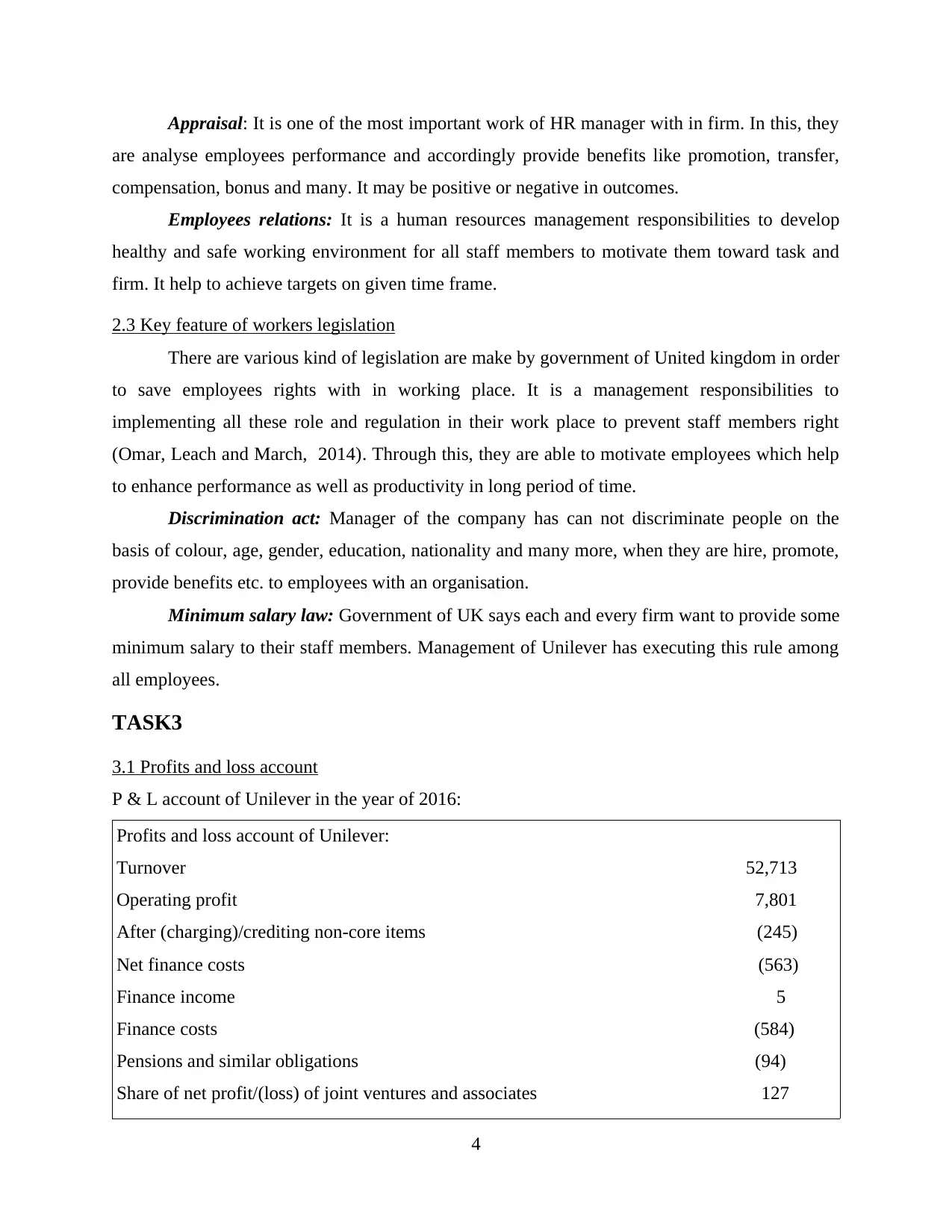
Appraisal: It is one of the most important work of HR manager with in firm. In this, they
are analyse employees performance and accordingly provide benefits like promotion, transfer,
compensation, bonus and many. It may be positive or negative in outcomes.
Employees relations: It is a human resources management responsibilities to develop
healthy and safe working environment for all staff members to motivate them toward task and
firm. It help to achieve targets on given time frame.
2.3 Key feature of workers legislation
There are various kind of legislation are make by government of United kingdom in order
to save employees rights with in working place. It is a management responsibilities to
implementing all these role and regulation in their work place to prevent staff members right
(Omar, Leach and March, 2014). Through this, they are able to motivate employees which help
to enhance performance as well as productivity in long period of time.
Discrimination act: Manager of the company has can not discriminate people on the
basis of colour, age, gender, education, nationality and many more, when they are hire, promote,
provide benefits etc. to employees with an organisation.
Minimum salary law: Government of UK says each and every firm want to provide some
minimum salary to their staff members. Management of Unilever has executing this rule among
all employees.
TASK3
3.1 Profits and loss account
P & L account of Unilever in the year of 2016:
Profits and loss account of Unilever:
Turnover 52,713
Operating profit 7,801
After (charging)/crediting non-core items (245)
Net finance costs (563)
Finance income 5
Finance costs (584)
Pensions and similar obligations (94)
Share of net profit/(loss) of joint ventures and associates 127
4
are analyse employees performance and accordingly provide benefits like promotion, transfer,
compensation, bonus and many. It may be positive or negative in outcomes.
Employees relations: It is a human resources management responsibilities to develop
healthy and safe working environment for all staff members to motivate them toward task and
firm. It help to achieve targets on given time frame.
2.3 Key feature of workers legislation
There are various kind of legislation are make by government of United kingdom in order
to save employees rights with in working place. It is a management responsibilities to
implementing all these role and regulation in their work place to prevent staff members right
(Omar, Leach and March, 2014). Through this, they are able to motivate employees which help
to enhance performance as well as productivity in long period of time.
Discrimination act: Manager of the company has can not discriminate people on the
basis of colour, age, gender, education, nationality and many more, when they are hire, promote,
provide benefits etc. to employees with an organisation.
Minimum salary law: Government of UK says each and every firm want to provide some
minimum salary to their staff members. Management of Unilever has executing this rule among
all employees.
TASK3
3.1 Profits and loss account
P & L account of Unilever in the year of 2016:
Profits and loss account of Unilever:
Turnover 52,713
Operating profit 7,801
After (charging)/crediting non-core items (245)
Net finance costs (563)
Finance income 5
Finance costs (584)
Pensions and similar obligations (94)
Share of net profit/(loss) of joint ventures and associates 127
4
⊘ This is a preview!⊘
Do you want full access?
Subscribe today to unlock all pages.

Trusted by 1+ million students worldwide
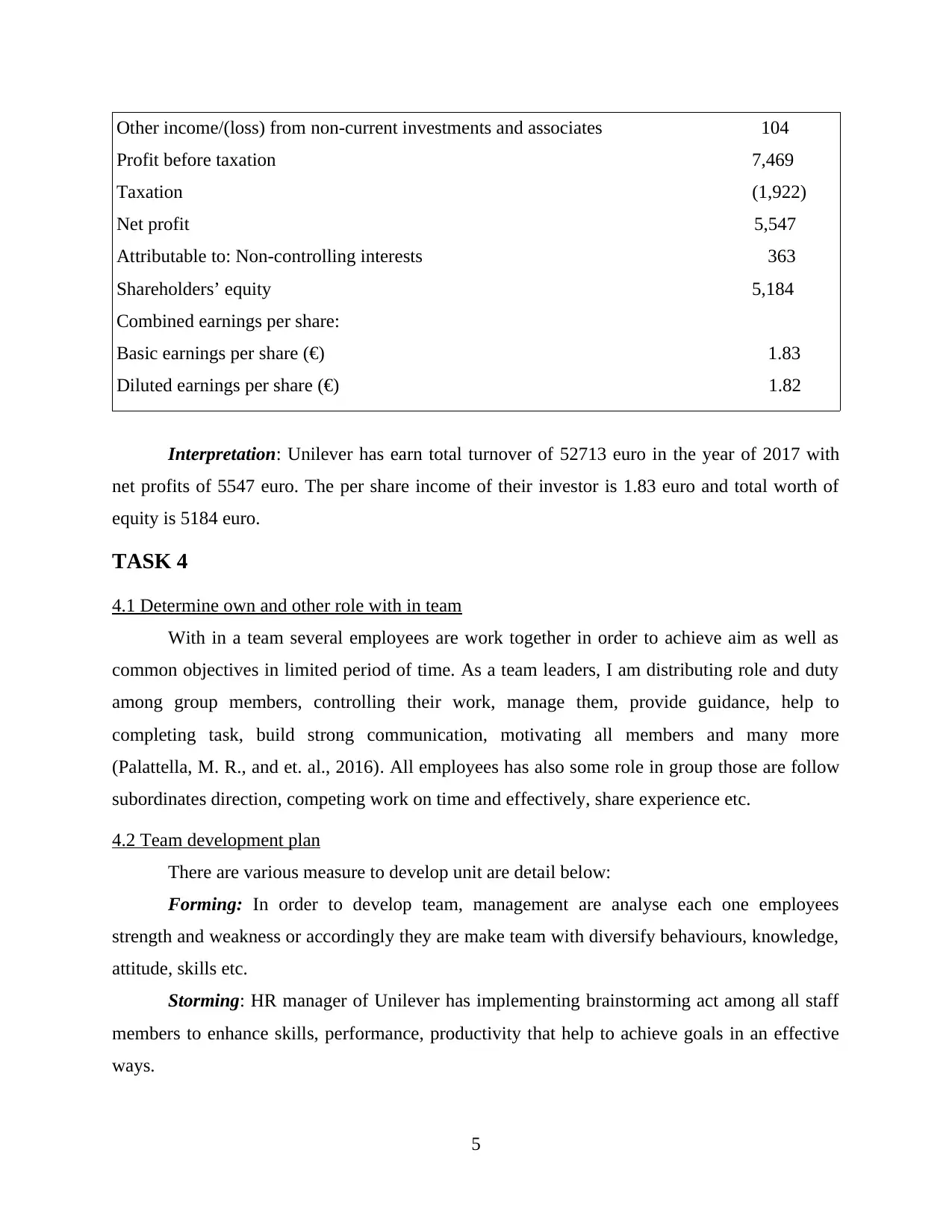
Other income/(loss) from non-current investments and associates 104
Profit before taxation 7,469
Taxation (1,922)
Net profit 5,547
Attributable to: Non-controlling interests 363
Shareholders’ equity 5,184
Combined earnings per share:
Basic earnings per share (€) 1.83
Diluted earnings per share (€) 1.82
Interpretation: Unilever has earn total turnover of 52713 euro in the year of 2017 with
net profits of 5547 euro. The per share income of their investor is 1.83 euro and total worth of
equity is 5184 euro.
TASK 4
4.1 Determine own and other role with in team
With in a team several employees are work together in order to achieve aim as well as
common objectives in limited period of time. As a team leaders, I am distributing role and duty
among group members, controlling their work, manage them, provide guidance, help to
completing task, build strong communication, motivating all members and many more
(Palattella, M. R., and et. al., 2016). All employees has also some role in group those are follow
subordinates direction, competing work on time and effectively, share experience etc.
4.2 Team development plan
There are various measure to develop unit are detail below:
Forming: In order to develop team, management are analyse each one employees
strength and weakness or accordingly they are make team with diversify behaviours, knowledge,
attitude, skills etc.
Storming: HR manager of Unilever has implementing brainstorming act among all staff
members to enhance skills, performance, productivity that help to achieve goals in an effective
ways.
5
Profit before taxation 7,469
Taxation (1,922)
Net profit 5,547
Attributable to: Non-controlling interests 363
Shareholders’ equity 5,184
Combined earnings per share:
Basic earnings per share (€) 1.83
Diluted earnings per share (€) 1.82
Interpretation: Unilever has earn total turnover of 52713 euro in the year of 2017 with
net profits of 5547 euro. The per share income of their investor is 1.83 euro and total worth of
equity is 5184 euro.
TASK 4
4.1 Determine own and other role with in team
With in a team several employees are work together in order to achieve aim as well as
common objectives in limited period of time. As a team leaders, I am distributing role and duty
among group members, controlling their work, manage them, provide guidance, help to
completing task, build strong communication, motivating all members and many more
(Palattella, M. R., and et. al., 2016). All employees has also some role in group those are follow
subordinates direction, competing work on time and effectively, share experience etc.
4.2 Team development plan
There are various measure to develop unit are detail below:
Forming: In order to develop team, management are analyse each one employees
strength and weakness or accordingly they are make team with diversify behaviours, knowledge,
attitude, skills etc.
Storming: HR manager of Unilever has implementing brainstorming act among all staff
members to enhance skills, performance, productivity that help to achieve goals in an effective
ways.
5
Paraphrase This Document
Need a fresh take? Get an instant paraphrase of this document with our AI Paraphraser
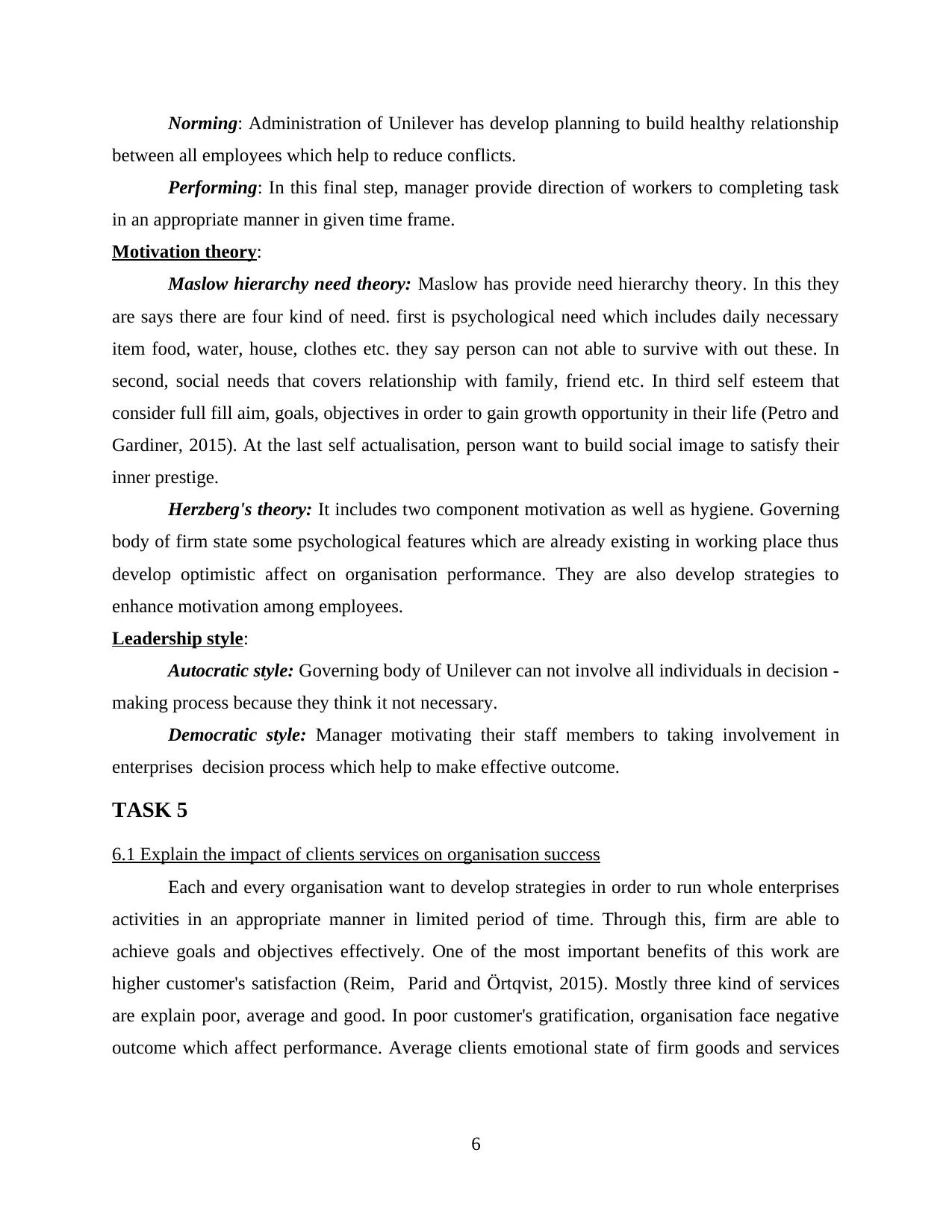
Norming: Administration of Unilever has develop planning to build healthy relationship
between all employees which help to reduce conflicts.
Performing: In this final step, manager provide direction of workers to completing task
in an appropriate manner in given time frame.
Motivation theory:
Maslow hierarchy need theory: Maslow has provide need hierarchy theory. In this they
are says there are four kind of need. first is psychological need which includes daily necessary
item food, water, house, clothes etc. they say person can not able to survive with out these. In
second, social needs that covers relationship with family, friend etc. In third self esteem that
consider full fill aim, goals, objectives in order to gain growth opportunity in their life (Petro and
Gardiner, 2015). At the last self actualisation, person want to build social image to satisfy their
inner prestige.
Herzberg's theory: It includes two component motivation as well as hygiene. Governing
body of firm state some psychological features which are already existing in working place thus
develop optimistic affect on organisation performance. They are also develop strategies to
enhance motivation among employees.
Leadership style:
Autocratic style: Governing body of Unilever can not involve all individuals in decision -
making process because they think it not necessary.
Democratic style: Manager motivating their staff members to taking involvement in
enterprises decision process which help to make effective outcome.
TASK 5
6.1 Explain the impact of clients services on organisation success
Each and every organisation want to develop strategies in order to run whole enterprises
activities in an appropriate manner in limited period of time. Through this, firm are able to
achieve goals and objectives effectively. One of the most important benefits of this work are
higher customer's satisfaction (Reim, Parid and Örtqvist, 2015). Mostly three kind of services
are explain poor, average and good. In poor customer's gratification, organisation face negative
outcome which affect performance. Average clients emotional state of firm goods and services
6
between all employees which help to reduce conflicts.
Performing: In this final step, manager provide direction of workers to completing task
in an appropriate manner in given time frame.
Motivation theory:
Maslow hierarchy need theory: Maslow has provide need hierarchy theory. In this they
are says there are four kind of need. first is psychological need which includes daily necessary
item food, water, house, clothes etc. they say person can not able to survive with out these. In
second, social needs that covers relationship with family, friend etc. In third self esteem that
consider full fill aim, goals, objectives in order to gain growth opportunity in their life (Petro and
Gardiner, 2015). At the last self actualisation, person want to build social image to satisfy their
inner prestige.
Herzberg's theory: It includes two component motivation as well as hygiene. Governing
body of firm state some psychological features which are already existing in working place thus
develop optimistic affect on organisation performance. They are also develop strategies to
enhance motivation among employees.
Leadership style:
Autocratic style: Governing body of Unilever can not involve all individuals in decision -
making process because they think it not necessary.
Democratic style: Manager motivating their staff members to taking involvement in
enterprises decision process which help to make effective outcome.
TASK 5
6.1 Explain the impact of clients services on organisation success
Each and every organisation want to develop strategies in order to run whole enterprises
activities in an appropriate manner in limited period of time. Through this, firm are able to
achieve goals and objectives effectively. One of the most important benefits of this work are
higher customer's satisfaction (Reim, Parid and Örtqvist, 2015). Mostly three kind of services
are explain poor, average and good. In poor customer's gratification, organisation face negative
outcome which affect performance. Average clients emotional state of firm goods and services
6
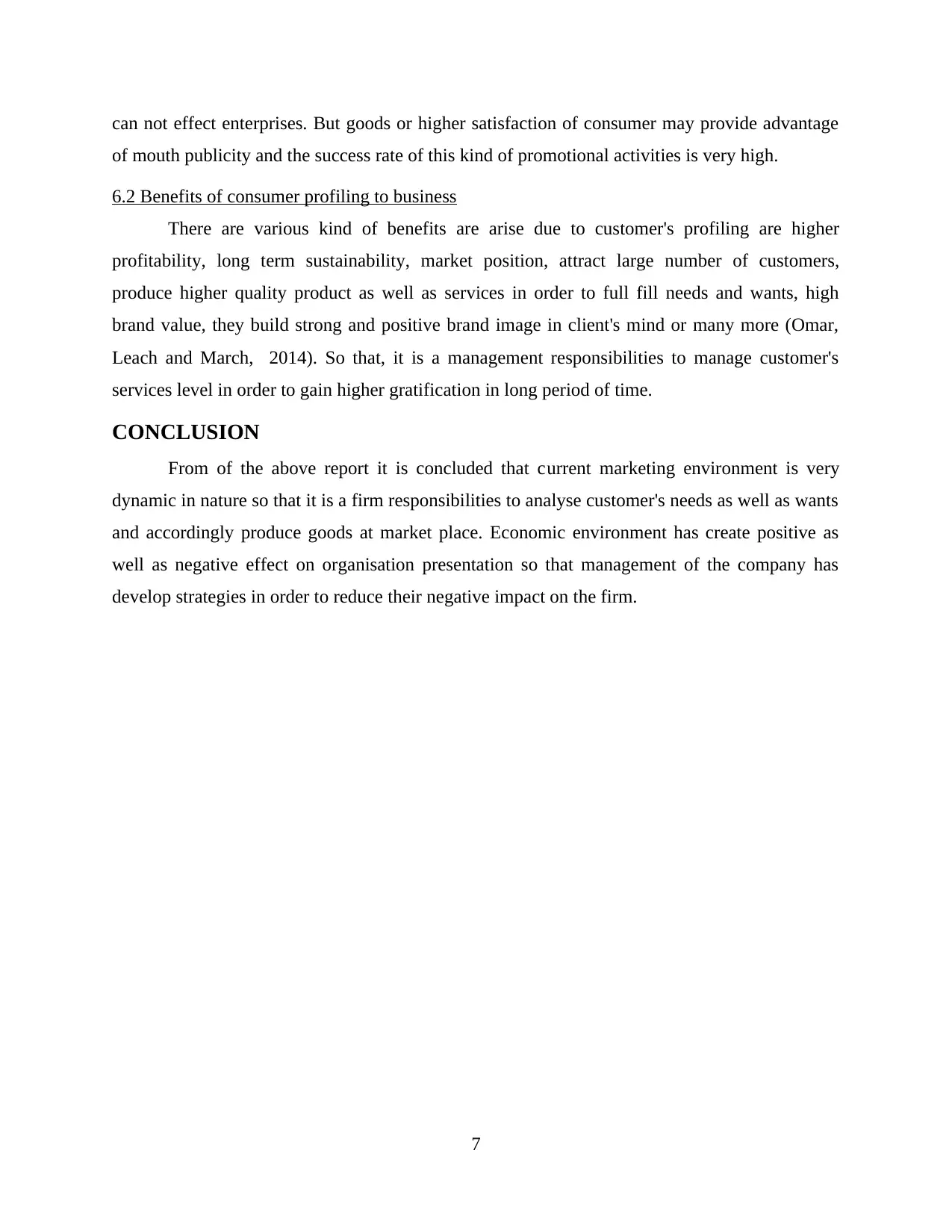
can not effect enterprises. But goods or higher satisfaction of consumer may provide advantage
of mouth publicity and the success rate of this kind of promotional activities is very high.
6.2 Benefits of consumer profiling to business
There are various kind of benefits are arise due to customer's profiling are higher
profitability, long term sustainability, market position, attract large number of customers,
produce higher quality product as well as services in order to full fill needs and wants, high
brand value, they build strong and positive brand image in client's mind or many more (Omar,
Leach and March, 2014). So that, it is a management responsibilities to manage customer's
services level in order to gain higher gratification in long period of time.
CONCLUSION
From of the above report it is concluded that current marketing environment is very
dynamic in nature so that it is a firm responsibilities to analyse customer's needs as well as wants
and accordingly produce goods at market place. Economic environment has create positive as
well as negative effect on organisation presentation so that management of the company has
develop strategies in order to reduce their negative impact on the firm.
7
of mouth publicity and the success rate of this kind of promotional activities is very high.
6.2 Benefits of consumer profiling to business
There are various kind of benefits are arise due to customer's profiling are higher
profitability, long term sustainability, market position, attract large number of customers,
produce higher quality product as well as services in order to full fill needs and wants, high
brand value, they build strong and positive brand image in client's mind or many more (Omar,
Leach and March, 2014). So that, it is a management responsibilities to manage customer's
services level in order to gain higher gratification in long period of time.
CONCLUSION
From of the above report it is concluded that current marketing environment is very
dynamic in nature so that it is a firm responsibilities to analyse customer's needs as well as wants
and accordingly produce goods at market place. Economic environment has create positive as
well as negative effect on organisation presentation so that management of the company has
develop strategies in order to reduce their negative impact on the firm.
7
⊘ This is a preview!⊘
Do you want full access?
Subscribe today to unlock all pages.

Trusted by 1+ million students worldwide
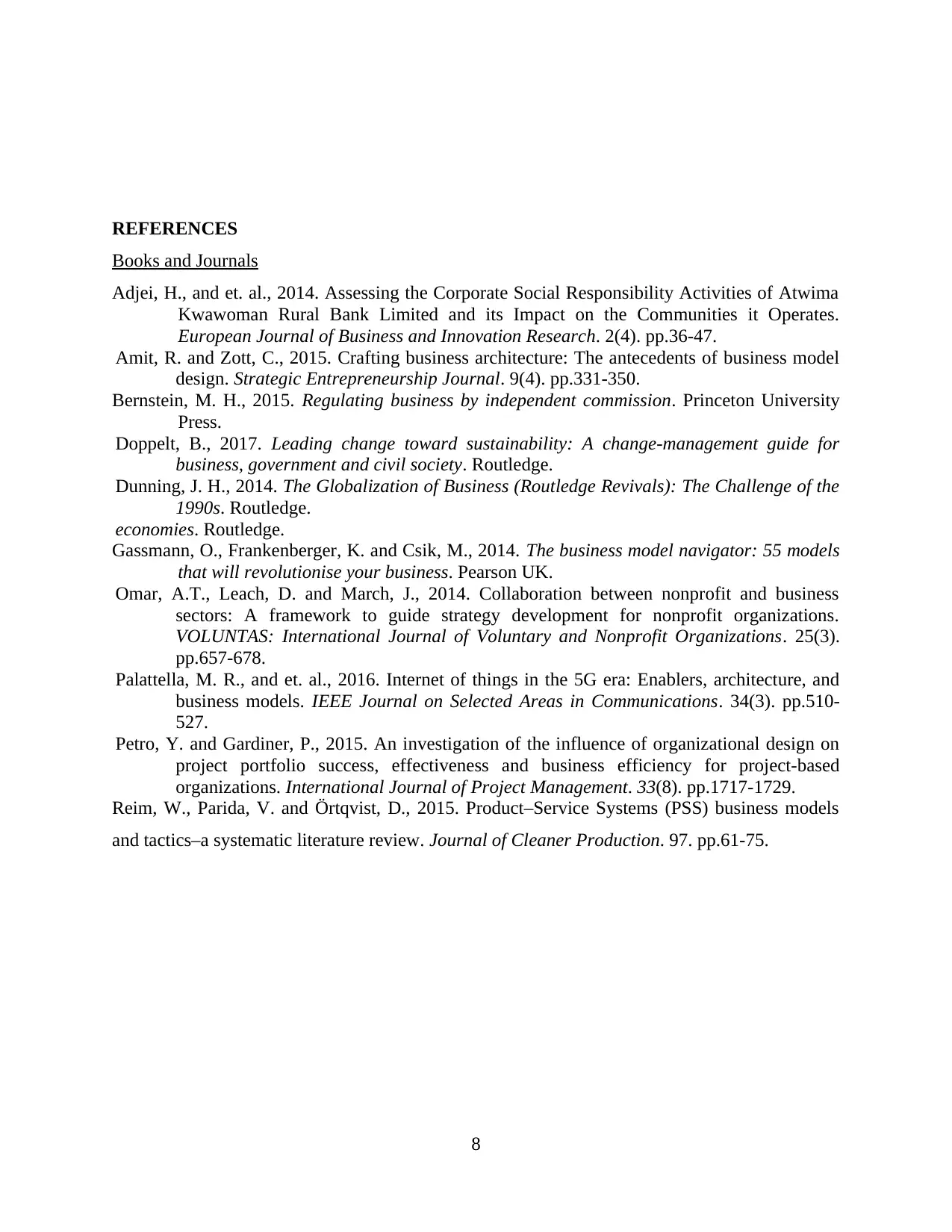
REFERENCES
Books and Journals
Adjei, H., and et. al., 2014. Assessing the Corporate Social Responsibility Activities of Atwima
Kwawoman Rural Bank Limited and its Impact on the Communities it Operates.
European Journal of Business and Innovation Research. 2(4). pp.36-47.
Amit, R. and Zott, C., 2015. Crafting business architecture: The antecedents of business model
design. Strategic Entrepreneurship Journal. 9(4). pp.331-350.
Bernstein, M. H., 2015. Regulating business by independent commission. Princeton University
Press.
Doppelt, B., 2017. Leading change toward sustainability: A change-management guide for
business, government and civil society. Routledge.
Dunning, J. H., 2014. The Globalization of Business (Routledge Revivals): The Challenge of the
1990s. Routledge.
economies. Routledge.
Gassmann, O., Frankenberger, K. and Csik, M., 2014. The business model navigator: 55 models
that will revolutionise your business. Pearson UK.
Omar, A.T., Leach, D. and March, J., 2014. Collaboration between nonprofit and business
sectors: A framework to guide strategy development for nonprofit organizations.
VOLUNTAS: International Journal of Voluntary and Nonprofit Organizations. 25(3).
pp.657-678.
Palattella, M. R., and et. al., 2016. Internet of things in the 5G era: Enablers, architecture, and
business models. IEEE Journal on Selected Areas in Communications. 34(3). pp.510-
527.
Petro, Y. and Gardiner, P., 2015. An investigation of the influence of organizational design on
project portfolio success, effectiveness and business efficiency for project-based
organizations. International Journal of Project Management. 33(8). pp.1717-1729.
Reim, W., Parida, V. and Örtqvist, D., 2015. Product–Service Systems (PSS) business models
and tactics–a systematic literature review. Journal of Cleaner Production. 97. pp.61-75.
8
Books and Journals
Adjei, H., and et. al., 2014. Assessing the Corporate Social Responsibility Activities of Atwima
Kwawoman Rural Bank Limited and its Impact on the Communities it Operates.
European Journal of Business and Innovation Research. 2(4). pp.36-47.
Amit, R. and Zott, C., 2015. Crafting business architecture: The antecedents of business model
design. Strategic Entrepreneurship Journal. 9(4). pp.331-350.
Bernstein, M. H., 2015. Regulating business by independent commission. Princeton University
Press.
Doppelt, B., 2017. Leading change toward sustainability: A change-management guide for
business, government and civil society. Routledge.
Dunning, J. H., 2014. The Globalization of Business (Routledge Revivals): The Challenge of the
1990s. Routledge.
economies. Routledge.
Gassmann, O., Frankenberger, K. and Csik, M., 2014. The business model navigator: 55 models
that will revolutionise your business. Pearson UK.
Omar, A.T., Leach, D. and March, J., 2014. Collaboration between nonprofit and business
sectors: A framework to guide strategy development for nonprofit organizations.
VOLUNTAS: International Journal of Voluntary and Nonprofit Organizations. 25(3).
pp.657-678.
Palattella, M. R., and et. al., 2016. Internet of things in the 5G era: Enablers, architecture, and
business models. IEEE Journal on Selected Areas in Communications. 34(3). pp.510-
527.
Petro, Y. and Gardiner, P., 2015. An investigation of the influence of organizational design on
project portfolio success, effectiveness and business efficiency for project-based
organizations. International Journal of Project Management. 33(8). pp.1717-1729.
Reim, W., Parida, V. and Örtqvist, D., 2015. Product–Service Systems (PSS) business models
and tactics–a systematic literature review. Journal of Cleaner Production. 97. pp.61-75.
8
Paraphrase This Document
Need a fresh take? Get an instant paraphrase of this document with our AI Paraphraser

9
1 out of 11
Related Documents
Your All-in-One AI-Powered Toolkit for Academic Success.
+13062052269
info@desklib.com
Available 24*7 on WhatsApp / Email
![[object Object]](/_next/static/media/star-bottom.7253800d.svg)
Unlock your academic potential
Copyright © 2020–2025 A2Z Services. All Rights Reserved. Developed and managed by ZUCOL.





